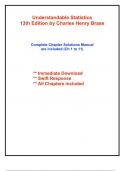Exam (elaborations)
Solutions for Understandable Statistics, 13th Edition Brase (All Chapters included)
- Course
- Institution
Complete Solutions Manual for Understandable Statistics, 13th Edition by Charles Henry Brase, Corrinne Pellillo Brase, Jason Mark Dolor, James Allen Seibert ; ISBN13: 9780357719176. (Full Chapters included Chapter 1 to 11)... 1. Getting Started. 2. Organizing Data. 3. Averages and Variation. 4....
[Show more]



